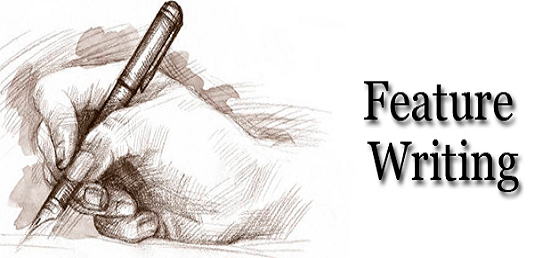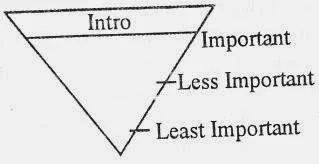HOW TO WRITE A FEATURE
In writing a feature, you will draw upon different skills.Structure of a Feature :
A feature is seldom written in the traditional inverted-pyramid pattern. The main point, always in the lead of a news story, may be withheld until the end as a climax. Or the feature may be written in a narrative fashion, much like a good joke or anecdote.
(A) Organize Carefully :
First decide what the theme is. Then carefully outline the sub-points so they will support the theme. The good feature requires as much organization as the straight news story, for the feature has to flow smoothly. News stories can be out without severely damaging the sense, but generally all the parts of a feature story must be kept intact if it is to succeed. A good test is to cut paragraphs from the body of a feature. If the story doesn't suffer from the cut, then the paragraphs probably aren't necessary. In the well-planned story, every paragraph-every sentence-should add to the total effect.
(B) Lead :
The lead must attract immediate attention and pull the reader into the story. Lead can vary in style and content. You can use description, narration, dialogue, questions, unusual statements, call to action, comparison, contrast.
(C) Transition :
No matter how good the lead is, you need a solid transition into the body of the feature. If you think of the lead as a lure to attract the audience, then the transition sets the hook. It makes the reader want to continue. And it promises some kind of satisfaction.
(D) Body :
Sound knowledge of the Subject, coupled with good writing skills, will take the readers through a variety of experiences. For this purpose, the usage of standard writing devices of script, dialogue, document-able but vivid fact and detailed careful observation, suspense and if appropriate plot is necessary.
(E) Conclusion :
The conclusion should give the reader a sense of satisfaction. So we should tie the conclusion to the lead for showing the unity of the story. It is done through a short, tight summary, occasionally we can conclude with an anecdote or a quote that sums up the substance of the story. With narrative approach then draw a conclusion.
Length of a Feature :
Feature stories can be of any length. The fact is, editors and news directors want this variety. In the case of a newspaper, it may be that a hole in the page requires a short item. The same is true on Radio or TV. A hole in the newscast can be plugged with a short feature-almost a filler.
Short feature fillers that have a light touch (sometimes called briles) a bit of humour, something heartwarming are particularly welcome in the newsroom.
With today’s typesetting technology of total pagination and automatic calculation of story length, the need to fill holes on a news page is not as common. Even so, the brief filler-feature is popular, for it gives the reader a break from the more serious straight news that dominates the page, and it helps and adds visual variety to a page.
Longer features are equally popular. In newspapers, they may be accompanied by photographs or artwork. As you work on a feature, think about possible illustrations or photographs to complement the story; For T.V. features, the visuals generally tell most of the story.
Structure of a Feature :
The difference between the structure of the news story and the feature is that news story is written in an inverted pyramid form.
But feature is written in a "pyramid form"
EP = Editorial Policy
PI= Presumable Interest
R1 = Readers Interest
These three rings are necessary for the feature writing and feature writer has to follow all these three rings while writing the feature.
Dramatic Structure :
In the dramatic structure of the feature, introduction comes first in which the subject is briefly introduced, then rising action comes and the subject goes on from introduction to rising action, then climax of event is described. Then, climax comes down towards the falling action and then finally the conclusion comes at the end of the feature where the conclusion of the story is drawn at last. Features are written very often in the
dramatic structure and the purpose behind this is to attract the reader’s attention towards the feature.












0 Comments